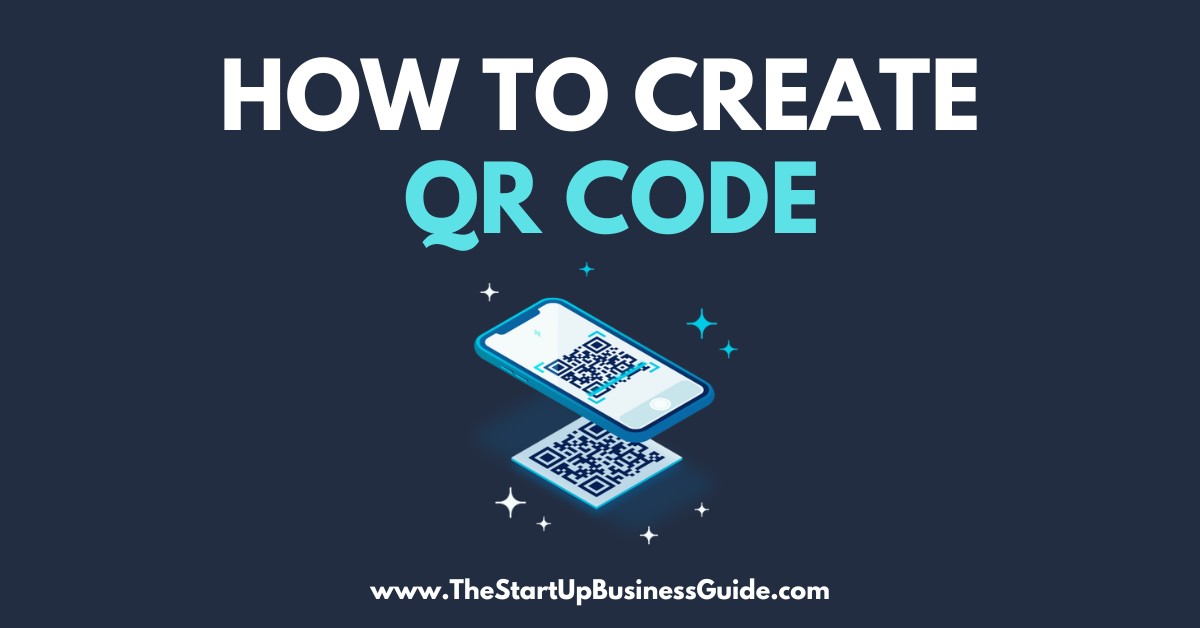How to Create a QR Code – Step-by-Step Guide

You may have seen these little squares before called ‘QR Codes’, but you may not know exactly what they are or how they can benefit your business.
A QR Code, or Quick Response Code, is a two-dimensional barcode that can store a variety of information, such as website URLs, contact information, or even text messages.
They’re called “Quick Response” codes because they allow users to quickly and easily access the information they contain by simply scanning the code with their smartphone camera.
But why should your business use QR Codes?
The benefits are numerous.
For one, QR Codes make it easy for customers to find and access important information about your business, such as your website, social media pages, or contact information.
They also allow you to track customer engagement and measure the success of your marketing efforts.
Plus, QR Codes can save you time and money by streamlining processes such as inventory management and product information tracking.
In this blog post, we’ll give you a detailed overview of QR Codes, including how they work, how to create them, and best practices for using them.
So whether you’re a small business owner or a marketing professional, you’ll find plenty of useful information to help you take advantage of the many benefits of QR Codes. So, let’s dive in!
How QR Codes Work
At its core, a QR Code is simply a two-dimensional barcode that can store a variety of information.
This information is encoded into the code using a pattern of black and white squares.
The QR Code itself is read by a scanner, which can be a smartphone camera or a dedicated QR Code scanning device.
The technology behind QR Codes is called “matrix barcoding,” and it was first developed in 1994 by a company called Denso Wave.
The QR in QR Code stands for “Quick Response,” and it was originally designed to be used in the automotive industry to track parts and inventory.
However, it quickly became clear that the technology could be used for a wide variety of other applications as well.
When a QR Code is scanned, the scanner uses a process called “image recognition” to read the code’s unique pattern of black and white squares.
Once the code has been read, the scanner decodes the information it contains and can take the appropriate action, such as opening a website, sending a text message, or displaying contact information.
Scanning a QR Code is incredibly easy and can be done with just about any smartphone or tablet.
All you need is a QR Code scanning app, which can be downloaded for free from the App Store or Google Play.
Once you have the app installed, you simply point your phone’s camera at the QR Code and the app will automatically scan and read the code.
In short, QR Codes are a simple yet powerful technology that makes it easy for businesses to share information and track customer engagement.
Understanding how QR Codes work is the first step to using them effectively in your business.
Generating QR Codes
Now that we’ve covered the basics of how QR Codes work, let’s talk about how you can create your own QR Codes for your business.
There are a variety of QR Code generator options available, each with their own pros and cons.
One of the most popular options for generating QR Codes is to use a free online QR Code generator.
These generators typically have a simple, user-friendly interface and allow you to create QR Codes quickly and easily.
However, free generators often have limited functionality and may include branding or watermarks on the generated QR Codes.
Another option is to use a paid QR Code generator.
These generators usually have more features and customization options than free generators, and they also often allow you to remove any branding or watermarks from the generated QR Codes.
However, paid generators can be more expensive and might require a subscription or usage-based fee.
When it comes to the best QR Code generators, it really depends on your specific use case and needs. Some popular options include:
- QR Code Generator: This site offers both free and paid plans with a wide range of customization options
- QR Code Monkey: Another free online QR Code generator with plenty of customization options
- QR Code Studio: A paid generator with advanced features like analytics and tracking.
Regardless of which generator you choose, be sure to consider the features that are important to you such as analytics, design, tracking and pricing. Some of the features that the best QR Code generators typically offer include the ability to create different types of QR Codes (such as URL, text, or contact information), the ability to customize the design of the QR Code, and the ability to track scans and get real-time analytics.
In summary, there are many options for generating QR Codes, from free online generators to paid options with more advanced features. It’s important to choose a generator that fits your specific needs and budget. With the right generator, you’ll be able to create high-quality, customized QR Codes that will help you reach your customers more effectively.
Creating Your Own QR Code
Now that you’ve chosen a QR Code generator, it’s time to start creating your own QR Codes.
In this section, we’ll walk you through the process step-by-step and provide some tips for designing effective QR Codes that will help you reach your customers.
- Step 1: Choose the type of QR Code you want to create. Different generators will offer different options, but common types include QR Codes for websites, email addresses, phone numbers, and text messages.
- Step 2: Enter the information you want to include in your QR Code. For example, if you’re creating a QR Code for a website, you’ll need to enter the URL of the website. If you’re creating a QR Code for a phone number, you’ll need to enter the phone number.
- Step 3: Customize the design of your QR Code. Most generators will allow you to choose the color and size of your QR Code, and some will even let you add a logo or image to the center of the QR Code.
- Step 4: Download or print your QR Code. Some generators will give you the option to download the QR Code as an image file, while others will allow you to print the QR Code directly from the site.
- Step 5: Place your QR Code in strategic locations. This is an important step, because if your customers can’t find or scan your QR Codes, they’re not going to do you much good. Some popular places to put QR Codes include on business cards, billboards, flyers, or even on the packaging of a product.
Now that you’ve learned how to create a QR Code, here are a few tips to keep in mind when designing them to be effective:
- Keep the design simple and easy to scan. Avoid adding too many colors or graphics that could interfere with the scanning process.
- Make sure the QR Code is large enough to be easily scanned. A general rule of thumb is to make the QR Code at least 1.5 inches by 1.5 inches.
- Test your QR Code before you print or distribute it. This will ensure that it’s working properly and that customers can easily scan it.
In summary, Creating your own QR Code is a simple process, it just involves choosing the type, inputting the information, customizing the design, download or print the code and place it strategically.
Effective QR Code design is key to ensure a good user experience, keep the design simple, make sure it is big enough and test it before distributing.
By following these best practices, you can be sure that your QR Codes are working for you and your business.
Scanning QR Codes
Scanning a QR Code is a quick and easy process, but there are a few things to keep in mind to ensure that you have a successful scan.
- Step 1: Download a QR Code scanning app. There are many QR Code scanning apps available for both iOS and Android devices, and most of them are free. Some popular options include QR Code Reader, QR Code Scanner, and QR Code Scan.
- Step 2: Open the QR Code scanning app. Once the app is installed, you can open it by tapping on the app icon.
- Step 3: Point your camera at the QR Code. Align the QR Code you want to scan within the viewfinder on your device’s screen.
- Step 4: Wait for the app to scan the QR Code. Most apps will automatically scan the QR Code when it is in focus and within the viewfinder. Some apps will also make a noise or show a message to indicate that the QR Code has been successfully scanned.
- Step 5: Follow the instruction or take the appropriate action. Once the QR Code has been scanned, the app will typically display the information contained within the code and give you the option to follow a link, send an email, make a call, etc.
Here are some tips to keep in mind when scanning QR Codes:
- Make sure the QR Code is well-lit. Low lighting can make it difficult to scan a QR Code, so try to scan the code in a well-lit area.
- Hold your device steady. A shaky hand can make it difficult to scan a QR Code, so try to hold your device as steady as possible.
- Keep the QR Code within the viewfinder. It’s important to keep the QR Code within the viewfinder of your device’s camera so the app can properly scan it.
- Check for updates. Regularly updating your QR Code scanning app will ensure that it’s up-to-date and able to properly scan the latest QR Code versions.
In summary, scanning QR Codes is easy and straightforward process, but there are a few things to keep in mind to ensure a successful scan.
By following these tips and instructions, you can be sure that you’re able to quickly and easily access the information contained within any QR Code you come across.
Different types of QR codes
One of the most common types of QR Codes is a QR Code for a website.
These codes simply contain a website URL, and when scanned, they take the user directly to that website.
This type of QR Code is useful for quickly directing customers to your business website, online store, or landing page.
Another popular type of QR Code is the Email QR Code.
These codes contain an email address, and when scanned, they open the user’s email app with the email address pre-populated in the recipient field, allowing customers to send an email to your business quickly and easily.
SMS QR Codes are similar to Email QR codes, but instead of opening the email app it opens the SMS app and the message to the desired number is pre-populated allowing users to quickly send a message.
Location QR Codes allow businesses to embed GPS coordinates into a QR Code, allowing customers to scan the code and be directed to a map showing the location of your business.
This type of QR Code is useful for brick-and-mortar businesses or events that want to make it easy for customers to find them.
Finally, vCard QR Codes allow businesses to include contact information, such as a phone number, email address, and address, into a QR Code.
When scanned, the information is automatically saved to the user’s device’s contact list, making it easy for customers to contact your business.
How QR codes are used in real world and business case studies
Let’s discuss about real-world applications of QR codes.
How are businesses actually using QR Codes to reach their customers and improve their operations?
In this section, we’ll take a look at some specific examples of how QR Codes are being used in the real world, and highlight some business case studies to illustrate their effectiveness.
One of the most common uses of QR Codes is in marketing campaigns.
For example, a clothing store might put QR Codes on their billboards or in-store posters, linking customers to special deals or discounts when they scan the code.
Similarly, a restaurant might print QR Codes on their menus, allowing customers to access nutritional information or view online reviews.
QR Codes are also commonly used for event ticketing and check-in.
By placing a QR Code on an event ticket, organizers can easily and quickly scan the code at the door for check-in, rather than manual registration or paper tickets.
QR Codes can also be used for inventory management.
For example, a warehouse might place QR Codes on its products, and use QR Code scanning to track inventory levels and monitor sales.
This can help streamline the inventory management process and improve efficiency.
One of the most notable use of QR codes is in healthcare, with the tracking of vaccine distribution and administration to patients.
Patients can scan the QR code on their vaccine record and have instant access to their personal vaccination information which can be shared with healthcare providers or used to prove vaccination status.
In all these examples and many more, businesses are using QR Codes to make things more convenient for their customers and more efficient for themselves.
By providing easy access to information and automating processes, QR Codes can help businesses save time and money while improving customer satisfaction.
Simply by understanding the potential applications of QR Codes, you can find creative ways to use them in your own business and see the benefits for yourself.
Advanced QR Code Features
One of the most useful advanced features of QR Codes is the ability to track and analyze scans.
Many QR Code generators include analytics, which allow you to see how many times a QR Code has been scanned, where scans are coming from, and which types of devices are being used to scan.
This information can be extremely valuable for businesses looking to measure the success of a marketing campaign or track customer engagement.
Another advanced feature is the ability to customize the design of your QR Code.
Many QR Code generators allow you to add a logo or image to the center of your QR Code, which can help make the code more visually appealing and make it stand out.
Some generators also allow you to add a color scheme or other design elements to your QR Code to match your business’s branding.
Finally, dynamic QR Codes are a type of QR Codes that can be edited or changed after they’ve been printed or distributed.
This allows businesses to update the information linked to the QR Code, such as a website URL, without having to reprint or redistribute the code.
This feature is particularly useful for businesses with constantly changing information, such as event schedules or menu items.
These advanced features are great tools to have in your arsenal, and can be a great way to make sure your QR Codes are working as hard as they can for your business.
Conclusion
In conclusion, QR Codes are a versatile and powerful tool for businesses of all sizes.
They can be used for a wide range of applications, from marketing campaigns to inventory management.
By using them effectively you’ll be able to reach and serve your customers well.






